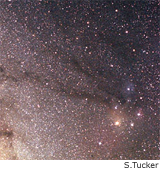[W-47795/47805] Professor

Eiichiro Komatsu
Office: RLM 16.210
Phone: (512) 471-1483
komatsu@astro.as.
utexas.edu
[Tu-47800] Professor

Daniel Jaffe
Office: RLM 17.218
Phone: (512) 471-3425
dtj@astro.as.utexas.edu

Course Website
[all sections] TA

Erin McMahon
Office: RLM 16.318
Phone: (512) 471-3466
emcmahon@astro.as.
utexas.edu
|
 |
Course Description
AST 101L is a laboratory course meant for non-science majors who either are taking or have taken AST 301.
In it you will work in groups to learn more about some of the experimental and observational topics you have
heard and read about in AST 301.
The class will be divided into groups of 4-5 students. Each group will work together to carry out three
3-week projects. The groups are selected based on which nights you have free to do the observing and on
which three segments you want to do most. If you are in the class with 3 or 4 friends, you can choose to form
a group. If you do not make up a whole 4 or 5 on your own, however, we may choose to split you up.
Schedule
There is one scheduled class hour each week of the semester. In addition, the groups will also have to meet at
other times to work on the projects. In some cases, you will need to gain access to restricted equipment; the
TA will be available during certain periods to allow this. At the end of each three week period, your group will
meet with the TA and/or the Prof. to discuss and evaluate the completed project.
The observational projects will work a bit differently than the others. For one thing, you will be expected to
devote some evening hours to the projects. Because these projects are so dependent on the weather, they
will be scheduled independently of the 3-week blocks. If your group chooses an observing project for one
of its three, you will need to come to class at one additional time during the first 3 weeks of the semester
to do the prep work. After that, you will need to carry out your observations on the first clear nights for
which your group has a slot available.
WARNING: It has often turned out in the past that there were entire three-week stretches without a clear weeknight.
You MUST "make hay while the moon shines" and get your observing done when you can. The upside of this is that
you may be done with this course early. Observing nights will be announced on our
class website
(see the big box on this webpage). You need to check this URL every afternoon until your observing project is completed.
|

